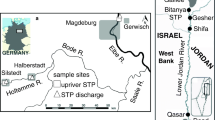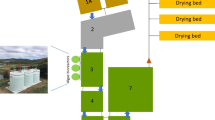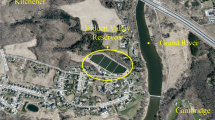Abstract
The main drinking water source supplying Uruguay (Santa Lucía River, SLR) was threatened in 2013 by a cyanobacterial bloom transported downstream to the water treatment plant that provides water to half of this country population. Several eutrophic reservoirs and stabilization ponds located in the river basin may have been the source of cyanobacterial populations. Such conditions may be common in productive basins; however, few studies have evaluated the impact of microalgae from wastewater stabilization ponds on rivers and its viability downstream. The effect of a dairy wastewater effluent on SLR was studied by means of nutrient and chlorophyll a loads, phytoplankton composition, and effluent incubation in river water in order to evaluate the potential development of cyanobacteria. Total phosphorus and nitrogen loads of the effluent reached up to 25% and 17% of SLR, respectively, while chlorophyll a was up to 37%. The upstream-downstream evaluation showed an increase in dissolved phosphorus and chlorophyll a. The effluent phytoplankton (14.16 mm3 L−1) was dominated by organisms < 10 μm and diatoms (91%), and 3% of cyanobacteria. Cyanobacteria were not detected in SLR, though it appeared downstream of the effluent discharge. At the end of the bioassay, cyanobacterial biomass became the dominant group (37%). This study shows the potential development of cyanobacteria present in industrial effluents when diluted in river water. The effect of phytoplankton discharge from stabilization ponds is not generally considered in monitoring assessments and environment management, despite representing a particular risk if the water body is used as a drinking water source.






Similar content being viewed by others
References
Aguilera, A., Aubriot, L., Echenique, R. O., Salerno, G. L., Brena, B. M., Pírez, M., & Bonilla, S. (2017). Synergistic effects of nutrients and light favor Nostocales over non-heterocystous cyanobacteria. Hydrobiologia, 794(1), 241–255. https://doi.org/10.1007/s10750-017-3099-1.
Ahmadi, A., Riahi, H., & Noori, M. (2005). Studies of the effects of environmental factors on the seasonal change of phytoplankton population in municipal waste water stabilization ponds. Toxicological & Environmental Chemistry, 87(4), 543–550. https://doi.org/10.1080/02772240500315456.
APHA. (1985). Standard methods for the examination of water and wastewater. Washington: APHA/AWWA/WPCF.
Arocena, R., Chalar, G., Fabián, D., de León, L., Brugnoli, E., Silva, M., et al. (2008). Evaluación ecológica de cursos de agua y biomonitoreo. ((Informe Final) ed.). Montevideo: MVOTMA -DINAMA, Universidad de la República-Facultad de Ciencias.
Aubriot, L., & Bonilla, S. (2018). Regulation of phosphate uptake reveals cyanobacterial bloom resilience to shifting N:P ratios. Freshwater Biology, 63(3), 318–329. https://doi.org/10.1111/fwb.13066.
Aubriot, L., Bonilla, S., & Falkner, G. (2011). Adaptive phosphate uptake behaviour of phytoplankton to environmental phosphate fluctuations. FEMS Microbiology Ecology, 77(1), 1–16. https://doi.org/10.1111/j.1574-6941.2011.01078.x.
Aubriot, L., Delbene, L., Haakonsson, S., Somma, A., Hirsch, F., & Bonilla, S. (2017). Evolution of eutrophication in Santa Lucía river: influence of land use intensification and perspectives. INNOTEC, 07-16, doi:https://doi.org/10.26461/14.04.
Azevedo, S. M. F. O., Carmichael, W. W., Jochimsen, E. M., Rinehart, K. L., Lau, S., Shaw, G. R., & Eaglesham, G. K. (2002). Human intoxication by microcystins during renal dialysis treatment in Caruaru-Brazil. Toxicology, 181-182, 441–446.
Barrera Bernal, C., Vázquez, G., Barceló Quintal, I., & Laure Bussy, A. (2008). Microalgal dynamics in batch reactors for municipal wastewater treatment containing dairy sewage water. Water, Air, and Soil Pollution, 190(1), 259–270. https://doi.org/10.1007/s11270-007-9598-3.
Bernard, C., Ballot, A., Thomazeau, S., Maloufi, S., Furey, A., Mankiewicz-Boczek, J., et al. (2017). Appendix 2: Cyanobacteria associated with the production of cyanotoxins. In J. Meriluoto, L. Spoof, & G. A. Codd (Eds.), Handbook of cyanobacterial monitoring and cyanotoxin analysis: John Wiley & Sons, Ltd.
Bonilla, S., Haakonsson, S., Somma, A., Gravier, A., Britos, A., Vidal, L., et al. (2015). Cianobacterias y cianotoxinas en ecosistemas límnicos de Uruguay. INNOTEC, 10, 9–22.
Borsuk, M. E., Stow, C. A., & Reckhow, K. H. (2002). Predicting the frequency of water quality standard violations: a probabilistic approach for TMDL development. Environmental Science & Technology, 36(10), 2109–2115. https://doi.org/10.1021/es011246m.
Chalar, G., Garcia-Pesenti, P., Silva-Pablo, M., Perdomo, C., Olivero, V., & Arocena, R. (2017). Weighting the impacts to stream water quality in small basins devoted to forage crops, dairy and beef cow production. Limnologica - Ecology and Management of Inland Waters, 65, 76–84. https://doi.org/10.1016/j.limno.2017.06.002.
Chen, B., Nam, S.-N., Westerhoff, P. K., Krasner, S. W., & Amy, G. (2009). Fate of effluent organic matter and DBP precursors in an effluent-dominated river: a case study of wastewater impact on downstream water quality. Water Research, 43(6), 1755–1765. https://doi.org/10.1016/j.watres.2009.01.020.
Chorus, I., & Bartram, J. (1999). Toxic cyanobacteria in water. A guide to their public health consequences, monitoring and management. London: World Health Organization.
Codd, G. A., Morrison, L. F., & Metcalf, J. S. (2005). Cyanobacterial toxins: risk management for health protection. Toxicology and Applied Pharmacology, 203(3), 264–272. https://doi.org/10.1016/j.taap.2004.02.016.
Conover, W. J., & Iman, R. L. (1976). On some alternative procedures using ranks for the analysis of experimental designs. Communications in Statistics - Theory and Methods, 5(14), 1349–1368. https://doi.org/10.1080/03610927608827447.
Cox, P. A., Banack, S. A., Murch, S. J., Rasmussen, U., Tien, G., Bidigare, R. R., Metcalf, J. S., Morrison, L. F., Codd, G. A., & Bergman, B. (2005). Diverse taxa of cyanobacteria produce β-N-methylamino-L-alanine, a neurotoxic amino acid. Proceedings of the National Academy of Sciences of the United States of America, 102(14), 5074–5078. https://doi.org/10.1073/pnas.0501526102.
DINAMA (2015). Evolución de la calidad en la cuenca del Santa Lucía. 10 años de información. (pp. 132). Montevideo: MVOTMA.
DINAMA-JICA. (2011). Proyecto sobre control de contaminación y calidad de agua en la cuenca del Río Santa Lucía. Informe final del proyecto. Montevideo: DINAMA.
Divina de Oliveira, M., & Calheiros, D. F. (2000). Flood pulse influence on phytoplankton communities of the south Pantanal floodplain, Brazil. Hydrobiologia, 427(1), 101–112. https://doi.org/10.1023/a:1003951930525.
Dodds, W. K., Bouska, W. W., Eitzmann, J. L., Pilger, T. J., Pitts, K. L., Riley, A. J., Schloesser, J. T., & Thornbrugh, D. J. (2009). Eutrophication of U.S. freshwaters: analysis of potential economic damages. Environmental Science & Technology, 43(1), 12–19. https://doi.org/10.1021/es801217q.
Dolman, A. M., Rücker, J., Pick, F. R., Fastner, J., Rohrlack, T., Mischke, U., et al. (2012). Cyanobacteria and cyanotoxins: the influence of nitrogen versus phosphorus. PLoS One, 7(6), e38757. https://doi.org/10.1371/journal.pone.0038757.
Dreher, T. W., Collart, L. P., Mueller, R. S., Halsey, K. H., Bildfell, R. J., Schreder, P., Sobhakumari, A., & Ferry, R. (2018). Anabaena/Dolichospermum as the source of lethal microcystin levels responsible for a large cattle toxicosis event. Toxicon: X, 100003, 100003. https://doi.org/10.1016/j.toxcx.2018.100003.
Drury, B., Rosi-Marshall, E., & Kelly, J. J. (2013). Wastewater treatment effluent reduces the abundance and diversity of benthic bacterial communities in urban and suburban rivers. Applied and Environmental Microbiology, 79(6), 1897–1905. https://doi.org/10.1128/aem.03527-12.
Elshorbagy, A., Teegavarapu, R. S. V., & Ormsbee, L. (2005). Total maximum daily load (TMDL) approach to surface water quality management: concepts, issues, and applications. Canadian Journal of Civil Engineering, 32(2), 442–448. https://doi.org/10.1139/l04-107.
Fabre, A., Carballo, C., Hernández, E., Piriz, P., Bergamino, L., Mello, L., et al. (2010). El nitrógeno y la relación zona eufótica/zona de mezcla explican la presencia de cianobacterias en pequeños lagos subtropicales, artificiales de Uruguay. Pan-American Journal of Aquatic Sciences, 5, 112–125.
Garnier, J., Ramarson, A., Thieu, V., Némery, J., Théry, S., Billen, G., & Coynel, A. (2018). How can water quality be improved when the urban waste water directive has been fulfilled? A case study of the Lot river (France). Environmental Science and Pollution Research, 25(12), 11924–11939. https://doi.org/10.1007/s11356-018-1428-1.
Hickey, C. W., Quinn, J. M., & Davies-Colley, R. J. (1989). Effluent characteristics of dairy shed oxidation ponds and their potential impacts on rivers. New Zealand Journal of Marine and Freshwater Research, 23(4), 569–584. https://doi.org/10.1080/00288330.1989.9516393.
Hillebrand, H., Dürselen, C., Kirschtel, D., Zohary, T., & Pollingher, U. (1999). Biovolume calculation for pelagic and benthic microalgae. Journal of Phycology, 35, 403–424.
Hilton, J., O'Hare, M., Bowes, M. J., & Jones, J. I. (2006). How green is my river? A new paradigm of eutrophication in rivers. Science of the Total Environment, 365(1), 66–83. https://doi.org/10.1016/j.scitotenv.2006.02.055.
Huisman, J., & Hulot, F. (2005). Population dynamics of harmful cyanobacteria. In J. Huisman, H. Matthijs, & P. Visser (Eds.), Harmful Cyanobacteria (Vol. 3, pp. 143-176, Aquatic Ecology Series): Springer Netherlands.
Jarvie, H. P., Neal, C., Williams, R. J., Neal, M., Wickham, H. D., Hill, L. K., Wade, A. J., Warwick, A., & White, J. (2002). Phosphorus sources, speciation and dynamics in the lowland eutrophic River Kennet, UK. Science of the Total Environment, 282-283, 175–203. https://doi.org/10.1016/S0048-9697(01)00951-2.
Jarvie, H. P., Neal, C., & Withers, P. J. A. (2006). Sewage-effluent phosphorus: a greater risk to river eutrophication than agricultural phosphorus? Science of the Total Environment, 360(1), 246–253. https://doi.org/10.1016/j.scitotenv.2005.08.038.
Jüttner, F., & Watson, S. B. (2007). Biochemical and ecological control of geosmin and 2-methylisoborneol in source waters. Applied and Environmental Microbiology, 73(14), 4395–4406. https://doi.org/10.1128/aem.02250-06.
Kasprzyk-Hordern, B., Dinsdale, R. M., & Guwy, A. J. (2009). The removal of pharmaceuticals, personal care products, endocrine disruptors and illicit drugs during wastewater treatment and its impact on the quality of receiving waters. Water Research, 43(2), 363–380. https://doi.org/10.1016/j.watres.2008.10.047.
Komárek, J. (2013). Cyanoprokaryota: Heterocytous Genera (Vol. 3, Süßwasserflora von Mitteleuropa, Vol. 19/3): Springer Spektrum.
Komárek, J., & Anagnostidis, K. (1998). Cyanoprokaryota. Chroococcales (Vol. 1, Süßwasserflora von Mitteleuropa). Stuttgart: Gustav Fisher Verlag.
Komárek, J., & Anagnostidis, K. (2007). Cyanoprokaryota. Oscillatoriales (Vol. 2, Süßwasserflora von Mitteleuropa). München: Spektrum Akademischer Verlag.
Komárek, J., Kaštovský, J., Mareš, J., & Johansen, J. R. (2014). Taxonomic classification of cyanoprokaryotes (cyanobacterial genera) 2014, using a polyphasic approach. Preslia, 86(4), 295–335.
Longhurst, R. D., Roberts, A. H. C., & O'Connor, M. B. (2000). Farm dairy effluent: a review of published data on chemical and physical characteristics in New Zealand. New Zealand Journal of Agricultural Research, 43(1), 7–14. https://doi.org/10.1080/00288233.2000.9513403.
Maberly, S. C., King, L., Dent, M. M., Jones, R. I., & Gibson, C. E. (2002). Nutrient limitation of phytoplankton and periphyton growth in upland lakes. Freshwater Biology, 47(11), 2136–2152. https://doi.org/10.1046/j.1365-2427.2002.00962.x.
Maere, T., Neethling, J. B., Clark, D., Pramanik, A., & Vanrolleghem, P. A. (2016) Wastewater treatment nutrient regulations: an international perspective with focus on innovation. In WEF/IWA Nutrient Removal and Recovery, Colorado, USA, July 2016 (pp. 10–13): Water Environment Federation and International Water Association.
Mainstone, C. P., & Parr, W. (2002). Phosphorus in rivers — ecology and management. Science of the Total Environment, 282-283, 25–47. https://doi.org/10.1016/S0048-9697(01)00937-8.
Masseret, E., Amblard, C., Bourdier, G., & Sargos, D. (2000). Effects of a waste stabilization lagoon discharge on bacterial and phytoplanktonic communities of a stream. Water Environment Research, 72(3), 285–294. https://doi.org/10.2175/106143000X137509.
Michalak, A. M., Anderson, E. J., Beletsky, D., Boland, S., Bosch, N. S., Bridgeman, T. B., Chaffin, J. D., Cho, K., Confesor, R., Daloglu, I., DePinto, J. V., Evans, M. A., Fahnenstiel, G. L., He, L., Ho, J. C., Jenkins, L., Johengen, T. H., Kuo, K. C., LaPorte, E., Liu, X., McWilliams, M. R., Moore, M. R., Posselt, D. J., Richards, R. P., Scavia, D., Steiner, A. L., Verhamme, E., Wright, D. M., & Zagorski, M. A. (2013). Record-setting algal bloom in Lake Erie caused by agricultural and meteorological trends consistent with expected future conditions. Proceedings of the National Academy of Sciences, 110(16), 6448–6452. https://doi.org/10.1073/pnas.1216006110.
Minnow-Environmental-Inc. (2005). Environmental risk-based approaches for managing municipal wastewater effluent (MWWE). (pp. 230). Ontario The Canadian Council of Ministers of the Environment.
Mosley, L. M. (2015). Drought impacts on the water quality of freshwater systems; review and integration. Earth-Science Reviews, 140, 203–214. https://doi.org/10.1016/j.earscirev.2014.11.010.
MVOTMA. (1979). Código de aguas (p. 14). Montevideo: MVOTMA.
MVOTMA (2013). Plan de acción para la protección del agua en la cuenca del Santa Lucía. In MVOTMA (Ed.). Montevideo: Ministerio de Vivienda, Ordenamiento Territorial y Medio Ambiente.
MVOTMA (2017). Plan Nacional de Aguas. In MVOTMA (Ed.). Montevideo: Ministerio de Vivienda, Ordenamiento Territorial y Medio Ambiente.
Neal, C., Jarvie, H. P., Neal, M., Love, A. J., Hill, L., & Wickham, H. (2005). Water quality of treated sewage effluent in a rural area of the upper Thames Basin, southern England, and the impacts of such effluents on riverine phosphorus concentrations. Journal of Hydrology, 304(1), 103–117. https://doi.org/10.1016/j.jhydrol.2004.07.025.
Nusch, E. (1980). Comparisons of different methods for chlorophyll and phaeopigments determination. Archiv für Hydrobiologie Ergebnisse der Limnologie, 14, 14–36.
O’Neill, K., Musgrave, I. F., & Humpage, A. (2016). Low dose extended exposure to saxitoxin and its potential neurodevelopmental effects: a review. Environmental Toxicology and Pharmacology, 48, 7–16. https://doi.org/10.1016/j.etap.2016.09.020.
Padulles, M. L., Conforti, V. T. D., Nannavecchia, P. S., & O'Farrell, I. (2017). Impacto de la contaminación orgánica sobre el fitoplancton de un arroyo de la llanura pampeana. Ecología Austral, 27, 437–448. https://doi.org/10.25260/EA.17.27.3.0.579.
Paerl, H. W., & Huisman, J. (2008). Blooms like it hot. Science, 320, 57–58.
Reichwaldt, E. S., & Ghadouani, A. (2012). Effects of rainfall patterns on toxic cyanobacterial blooms in a changing climate: between simplistic scenarios and complex dynamics. Water Research, 46(5), 1372–1393. https://doi.org/10.1016/j.watres.2011.11.052.
Reynolds, C. S. (2006). The ecology of phytoplankton. Cambridge: Cambridge University Press.
Reynolds, C. S., & Descy, J.-P. (1996). The production, biomass and structure of phytoplankton in large rivers. Archiv für Hydrobiologie, Supplement. Large Rivers, 10(1–4), 161–187. https://doi.org/10.1127/lr/10/1996/161.
Rojo, C., Cobelas, M. A., & Arauzo, M. (1994). An elementary, structural analysis of river phytoplankton. Hydrobiologia, 289(1), 43–55. https://doi.org/10.1007/bf00007407.
Schindler, D. W. (1977). Evolution of phosphorus limitation in lakes. Science, 195, 260–262.
Schindler, D. W., Hecky, R. E., Findlay, D. L., Stainton, M. P., Parker, B. R., Paterson, M. J., Beaty, K. G., Lyng, M., & Kasian, S. E. M. (2008). Eutrophication of lakes cannot be controlled by reducing nitrogen input: results of a 37-year whole-ecosystem experiment. Proceedings of the National Academy of Sciences of the United States of America, 105(32), 11254–11258. https://doi.org/10.1073/pnas.0805108105.
Sinha, E., Michalak, A. M., & Balaji, V. (2017). Eutrophication will increase during the 21st century as a result of precipitation changes. Science, 357(6349), 405–408. https://doi.org/10.1126/science.aan2409.
Sournia, A. (1978). Phytoplankton Manual (Monographs on Oceanographic Methodology. N° 6). Paris: UNESCO.
Sukias, J. P. S., Tanner, C. C., Davies-Colley, R. J., Nagels, J. W., & Wolters, R. (2001). Algal abundance, organic matter, and physico-chemical characteristics of dairy farm facultative ponds: Implications for treatment performance. New Zealand Journal of Agricultural Research, 44(4), 279–296. https://doi.org/10.1080/00288233.2001.9513485.
Svirčev, Z., Drobac, D., Tokodi, N., Vidović, M., Simeunović, J., Miladinov-Mikov, M., et al. (2013). Epidemiology of primary liver cancer in Serbia and possible connection with cyanobacterial blooms. Journal of Environmental Science and Health, Part C, 31(3), 181–200. https://doi.org/10.1080/10590501.2013.824187.
UDELAR. (2013). Informe sobre la calidad del agua en la cuenca del Río Santa Lucía: estado de situación y recomendaciones (p. 29). Montevideo: Universidad de la República.
URSEA (2017). Informe de situación de las medidas que se están implementado para el aseguramento de la potabilización del agua del sistema de abastecimiento de Montevideo y Laguna del Sauce. In L. A. 5/2016 (Ed.), (pp. 90). Montevideo.
Uruguay (1979). (Vol. 31 de mayo de 1979, pp. p. 1473). Montevideo: Diario Oficial.
Valderrama, J. C. (1981). The simultaneous analysis of total nitrogen and total phosphorus in natural waters. Marine Chemistry, 10, 109–122.
Vidal, F., Sedan, D., D’Agostino, D., Cavalieri, M., Mullen, E., Parot Varela, M., Flores, C., Caixach, J., & Andrinolo, D. (2017). Recreational exposure during algal bloom in Carrasco Beach, Uruguay: a liver failure case report. Toxins, 9(9), 267.
Wool, T. A., Davie, S. R., & Rodriguez, H. N. (2003). Development of three-dimensional hydrodynamic and water quality models to support total maximum daily load decision process for the Neuse River Estuary, North Carolina. Journal of Water Resources Planning and Management, 129(4), 295–306. https://doi.org/10.1061/(ASCE)0733-9496(2003)129:4(295).
Yu, Q., Chen, Y., Liu, Z., de Giesen, N., & Zhu, D. (2015). The influence of a eutrophic lake to the river downstream: spatiotemporal algal composition changes and the driving factors. Water, 7(5), 2184–2201.
Acknowledgments
We are grateful to Federica Hirsch, Bruno Cremella, and Mariana Illarze for field work and laboratory analyzes, as well as to the anonymous reviewers for their helpful comments.
Funding
The study was financed by the Comisión Sectorial de Investigación Científica - Universidad de la República (UDELAR-CSIC) and the Programa de Apoyo a la Investigación Estudiantil (PAIE).
Author information
Authors and Affiliations
Corresponding author
Additional information
Publisher’s note
Springer Nature remains neutral with regard to jurisdictional claims in published maps and institutional affiliations.
Electronic supplementary material
ESM 1
(DOCX 12.9 kb)
Rights and permissions
About this article
Cite this article
Olano, H., Martigani, F., Somma, A. et al. Wastewater discharge with phytoplankton may favor cyanobacterial development in the main drinking water supply river in Uruguay. Environ Monit Assess 191, 146 (2019). https://doi.org/10.1007/s10661-019-7288-4
Received:
Accepted:
Published:
DOI: https://doi.org/10.1007/s10661-019-7288-4




